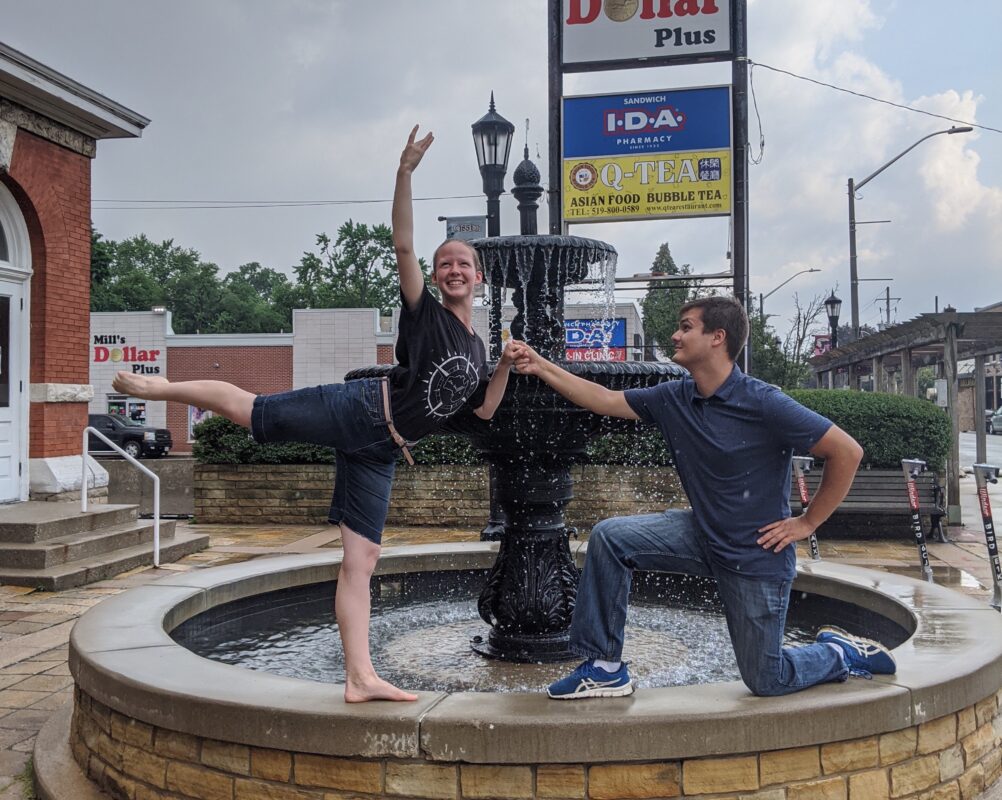When I was 10, I told myself, “This is what I want to do for the rest of my life.”
I was talking about ballet. My cousin is a professional ballerina, and she gave lessons to me and four of my sisters in the empty apartment above my house. The dusty, slanted, water-damaged and creaky hardwood floor didn’t make the best dance floor, but we didn’t know better. I fell in love with the beauty of ballet and with the demands it made on me – it pushed me hard and required great things from me. I never wanted to stop.
A few years later, I did want to stop. Ballet was hard and often not as rewarding as I hoped it would be. My younger sisters were more flexible than I was and picked up the routines faster; I experienced my first mid-life crisis at 12, as I seriously debated switching careers.
I powered through, and at 14, I told myself again, “I want to do this for the rest of my life.” My love and determination grew as I continued to self-teach and take any classes I could, and I told myself again at 15, 16, and 17, “I want to do this for the rest of my life.”

That’s the moment that most people want to have when we make plans for our lives. I’ve been told by many people to embrace that and not let go of it. If that’s what you’re passionate about, chase it! If that’s what makes you happy, don’t let go of it!
I went to Florida on a week-long trip with CCBR to talk to university students about abortion when I was 17. I had gone the previous year and was so inspired that I had to go again, but this time it hit me differently. I realized that it wasn’t just American children who were being killed by abortion, but nearly 300 Canadian children every day as well. It wasn’t just children across the country, but children in Windsor—in my neighborhood.
When I came back from that week in Florida, I started volunteering with Windsor Against Abortion – determined to make a difference in my city. I was able to volunteer about 2 hours–sometimes 3 or 4 hours–per week to change hearts and minds and save lives.
I worked 30-40 hours per week at McDonalds and spent 20-28 hours per week training and conditioning myself to be a dancer. My goal was to increase my training hours to about 60/week, which is what I would need if I was going to dance professionally.
I started to wrestle with a different question: “Can I afford to do this for the rest of my life?
I could, certainly. It was a workload I would happily take on in order to achieve my dream, but how could I justify spending 60 hours/week working toward something I wanted while 2100 helpless children were killed in that same amount of time?
Part of my inspiration for wanting to be a dancer was that dance had spoken to me during some dark times of my life, and stirred hope within me where it hadn’t existed before. I wanted to give that gift to other people – to bring hope where there was hopelessness, and touch a part of someone that only art can touch. But the more I thought about it, the more my attention was drawn to the need.
If nearly 300 toddlers were being slaughtered every day in Canada, would I be content to volunteer for 2-4 hours/week and try not to think about them the rest of the time? Would I be content to train myself to be a dancer to meet the emotional needs of a few people and ignore the lives of innocent children?
Further, I asked myself, “What if hardly anyone was willing to do anything about it?”
There were many people who were willing to become dancers, but only a handful who were willing to put aside their other aspirations to save these children.
My thoughts were echoed by Gregg Cunningham, who was working full-time in the pro-life movement at the time:
“There are more people working full-time to kill babies than to save babies, because killing babies is profitable and saving babies is costly.”
There isn’t a shortage of dancers – there are more dancers than professional companies can hire – but there is a shortage of pro-life activists.
I imagined what it would look like to work full-time to save babies – talking to people on the streets to show them the humanity of pre-born children and the inhumanity of abortion, inspiring other pro-lifers to start defending the lives of innocents, fundraising (since saving babies is costly) and behind-the-scenes work to make it all possible.
Journalist Elaine Godfrey interviewed Abortionist Warren Hern, who gave a glimpse into what it is like to work full-time to kill babies. She wrote:
“In the 1970s…once or twice, during a procedure at 15 or 16 weeks, he used forceps to remove a fetus with a still-beating heart. The heart thumped for only a few seconds before stopping. But for a long while after, a vision of that fetus would wake Hern from sleep. He could see it in his mind, the inches-long body and its heart: beating, beating, beating.”
It seemed like everywhere I turned, I found the answer to my question: “Can I afford to do this for the rest of my life?” I heard the story of Sophie Scholl, who died young at the hands of Nazis because of her resistance work with the White Rose. She famously said,
“How can we expect righteousness to prevail when there is hardly anyone willing to give himself up individually to a righteous cause?”
Surely Sophie had dreams, but she knew that someone had to set aside their ambitions to fight injustice. If it was Sophie, I found that I couldn’t explain why it shouldn’t be me. Someone had to defend innocent children. Yet, somehow, almost no one “felt called” to it.
I wrestled with these feelings until I was 19 years old, when I decided to take a break from dancing to discern what I should do.
After asking myself for years as I trained in ballet, “Do I want to keep doing this for the rest of my life?” and answering, “Yes!” I stood outside on a rainy day behind a sign which showed a picture of a victim of abortion. The picture was so brutal it was hard even for me to look at – it showed what Warren Hern called “a destructive operation on a form that is similar to our own.” A tiny body that was ripped apart and covered in blood. It was unclear whether it was a boy or a girl, and unclear whether the blood was her own or her mother’s – and I watched the looks of horror on people’s faces as they hurried by. I asked myself, “Do I want to keep doing this for the rest of my life?”
The answer came easily. NO.
I want to stop doing this as fast as possible.
I want to stop showing pictures of dead children because no one needs to be shown anymore – because the photos are outdated records of the past. The moment there is no longer a demand for abortion in Canada is the moment I will start to re-imagine what I want to do with the rest of my life. Until then, I will do what someone must.
To borrow the words of Gregg Cunningham again: “It’s not my passion, it’s my conviction.”
I haven’t trained again since December 2018, because my children will inherit the world that I helped to create, and I want them to be able to chase their dreams. I want them to be able to decide to spend 60 hours/week dancing, without knowing that there are children who need someone to set aside their dreams to save them.
I want those children to ask, “What do I want to do for the rest of my life?” instead of “the rest of their life” lasting only a few weeks or months until they are torn apart.
I work full-time in the pro-life movement because I can’t afford to do something else. In an ideal world, I would be working to accomplish my dreams, but in a society that kills innocent children, I don’t have the luxury of working to accomplish my dreams.
“Do I want to keep doing this for the rest of my life?”
The point of asking that question is supposed to be that if the answer is yes do it – and if no don’t. Yet this is the paradox of the pro-life movement: None of us want to be here. Our goal is to work ourselves out of a job.
Some might say that I am wasting my potential working full-time in the pro-life movement at 24, and perhaps that is true. In some ways, it almost certainly is.
Sophie Scholl “wasted her potential” by joining the White Rose resistance and being killed at 21, but her goal was not to have a successful career, her goal was a better world.
“Such a fine sunny day, and I have to go, but what does my death matter, if through us thousands of people are awakened and stirred to action?” -Sophia Scholl
If Sophie decided to be the one to give up her life, then I can’t answer why I shouldn’t be the one to give up my dream. What dream is worth more than the lives of innocent children?
